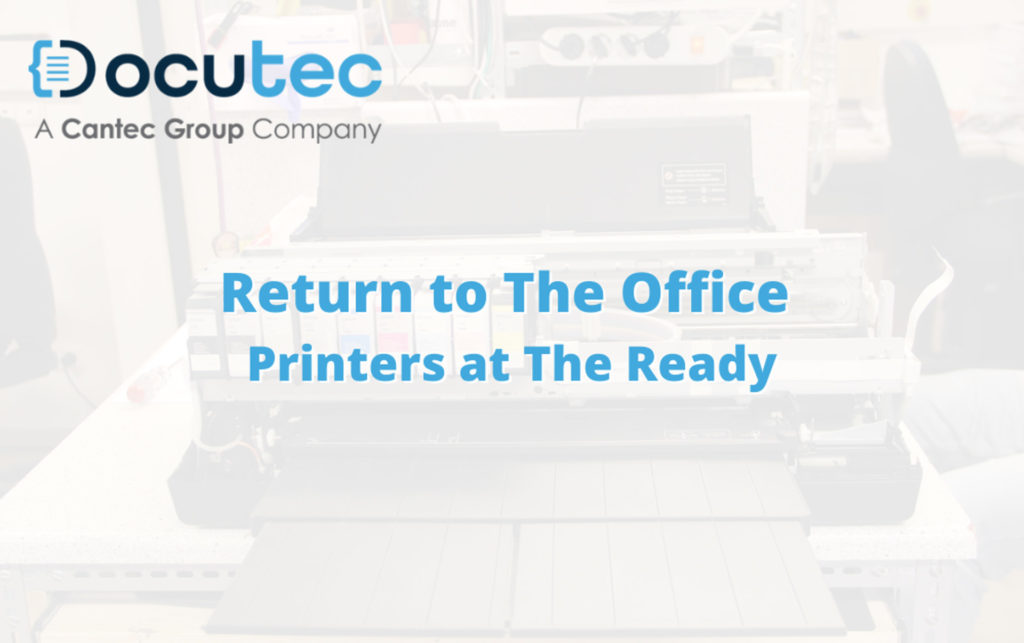
The “Great Return” is upon us. As workers return for the office for the first time in 18 months it’s important to ensure the space is up to scratch.
The return of workers can mean increased costs as office printers roar back into life, however with a Managed Print Service in your business you can effectively manage document workflow, establish a useful, predictable cost per page whilst increasing productivity and reducing your overall print cost.
How does Managed Print Service Work?
Printing is an essential function for most businesses, but every business approaches printing in a different way. Some organisations may benefit from powerful, high volume printers capable of producing tens of thousands of sheets per month, whereas some organisations may benefit from a more compact, desktop printer.
Think of engineers, architects, manufacturers and landscapers, they can benefit from the use of large format printers specifically an A0 Printer or an A1 Printer, there are options to suit everyone. A managed print service is an option we offer at Docutec that comprehensively manages all aspects of your day-to-day business printing. But why do you need it?
- SCRAP ‘LOCAL’ PRINTERS
The first thing that will need to be assessed is the use of local printers, usually, these are far more costly than you realise and are quite inefficient. In most cases, these printers only serve one user and are almost never networked, which is a big no-no in the modern-day office space. These ‘local’ printers often use brand exclusive ink cartridges which are usually more expensive and harder to acquire. - IMPROVE EFFICIENCY
By engaging with a Managed Print Service provider, you can easily pinpoint which machines in your office are underperforming and have them replaced with a far more efficient unit. No two businesses are the same, our expert technicians here at Docutec can choose the right printer for you and your budget, considering both business goals and printing history. - REMOTE PRINTING
With the hybrid model becoming common place now, mobile printing is going to become more important than ever before. These units will allow you to print remotely from locations away from the office, so an employee doesn’t have to come all the way into the office to print an important document. - REDUCE IT DEPARTMENT WORKLOAD
Your IT Department is usually busy, slogging away on their regular tasks – The last thing they want to do is to fix a jam in the office printer as this takes time away from more important jobs. By using a Managed Print Services provider you’re ensuring your employees will be trained on how to effectively use the new printers and also avail of remote help desk support for any issues that may crop up.
What Printer is Best for Me?
First, you need to ask yourself a few questions.
- How much printing will be done per month?
- What type of documents do you print?
- Are these black & white or colour documents?
- Is this a shared printer?
- How much space do you have for the printer?
- Do you need only a printer or a unit with an office photocopier printer, document scanner or even a fax machine?
You’re spoilt for choice when it comes to printers, from specialist units to Canon specialist multifunction printers. Once you’ve determined your printing needs you can narrow your search down, here’s what you must consider.
- SPEED
On average, printers can handle 15 pages per minute. If you require hundreds of documents to be printed each day, then you will really need to prioritise printer speed. There are printers that can produce up to 70 pages per minute which may suit certain needs. - THE DUTY CYCLE
Every printer has something called a duty cycle. This is effectively the maximum number of pages the printer can produce in a month; this number differs depending on the make and model of the printer. We would always recommend that you choose a printer with a higher duty cycle than what you actually require, this is done to improve the longevity of the printer. On average most printers can hit about 10’000 pages per month. Generally, as you go up the line of printers the duty cycle will increase. - PAPER TRAYS
Most printer trays can hold around 150 pages, however if you’re printing 3-500 pages per day, you’re going to need something bigger, no one wants to be constantly refilling paper trays every hour! Larger printers can fit about 250 pages in their trays and this capacity can be further extended with attachments, business printers then can handle upwards of 1,000 pages through various trays in the machine. - INK TYPE
Inkjet and Laser – The two main major ink types. In simple terms, inkjet sprays ink onto the page using fine drops whereas a laser printer rolls ink onto the page via the laser itself. These two solutions differ greatly in quality, cost, speed, and maintenance. Generally speaking, if you’re printing mostly text-based documents, you should choose a laser printer. If you’re printing things like fliers, brochures and colour photos, try inkjet.
You’ve also got to consider that a Black & White only laser printer is a far more affordable option than its inkjet counterpart, the replacement cartridges are also cheaper. Laser printers only use one black ink cartridge, whereas an inkjet printer will use a black cartridge and three separate colour cartridges, yellow, magenta and cyan. You’ll need to replace every cartridge for full-colour print jobs. - COST PER PAGE
As a general rule of thumb, buying a cheaper printer will mean the cost per page will go up whereas a mid-level printer will cost far less to print pages. Cheaper printers usually mean more expensive ink, on average inkjet printers cost about 20 cents per page whilst a laser printer clocks in around 7 cents per page.
Buying Or Leasing, what’s best?
Depending on your business needs, leasing a printer as part of a managed print service could perfectly suit you. Leasing allows you to avail of the most up to date printer hardware & software without having to splash the cash.
For example, a canon printer lease is usually taken out over 3-5 years. There are regular, fixed payments which allow you to accurately forecast cash flow and easily budget per month, years in advance.
Also, the interest paid on your Canon printer lease can actually be written off every year against your company profits. This is the most efficient method of procuring a printer for your business rather than an outright purchase.
Here at Docutec, we also offer short term printer hire, we understand that sometimes businesses may only need a printer for a small period to maintain a solid stock of business printers just for this purpose.
Make sure you’re prepared for the return to the office, with options, printers and plans to suit every form of business Docutec are the go-to for print solutions. With offices in Cork, Limerick, Waterford and beyond, Docutec is more than equipped to help you with all your printing needs.











